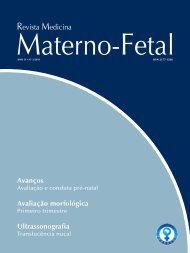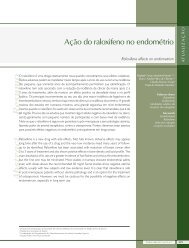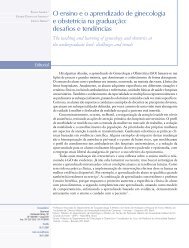Riscos e benefÃcios do uso dos inibidores seletivos da ... - Febrasgo
Riscos e benefÃcios do uso dos inibidores seletivos da ... - Febrasgo
Riscos e benefÃcios do uso dos inibidores seletivos da ... - Febrasgo
Create successful ePaper yourself
Turn your PDF publications into a flip-book with our unique Google optimized e-Paper software.
<strong>do</strong>teliais, entre outras 21 . Além disso, o raloxifeno tem<br />
mostra<strong>do</strong> reduzir os níveis séricos <strong>do</strong> fator de necrose<br />
tumoral-alfa (TNF-α) pela metade após 24 meses de<br />
tratamento em mulheres menopausa<strong>da</strong>s 22 . O TNF-α<br />
é um peptídeo secreta<strong>do</strong> por macrófagos ativos, cuja<br />
secreção é estimula<strong>da</strong> pela hipóxia tecidual e que tem<br />
se mostra<strong>do</strong> um potente estimula<strong>do</strong>r <strong>da</strong> angiogênese<br />
em ensaios in vivo 23 . O raloxifeno também se mostrou<br />
eficaz em inibir a proliferação celular no teci<strong>do</strong> mamário<br />
normal 11 .<br />
Referências<br />
1. Folkman J. Role of angiogenesis in tumor growth and metastasis.<br />
Semin Oncol. 2002;29(6 Suppl 16):15-8.<br />
2. Marson LP, Kurian KM, Miller WR, Dixon JM. The effect of<br />
tamoxifen on breast tumour vascularity. Breast Cancer Res Treat.<br />
2001;66(1):9-15.<br />
3. Bottini A, Berruti A, Bersiga A, Brizzi MP, Allevi G, Bolsi G, et al.<br />
Changes in microvessel density as assessed by CD34 antibodies<br />
after primary chemotherapy in human breast cancer. Clin Cancer<br />
Res. 2002;8(6):1816-21.<br />
4. Kato T, Kameoka S, Kimura T, Nishikawa T, Kobayashi M. The combination<br />
of angiogenesis and blood vessel invasion as a prognostic indicator<br />
in primary breast cancer. Br J Cancer. 2003;88(12):1900-8.<br />
5. <strong>da</strong> Silva BB, <strong>da</strong> Silva Junior RG, Borges US, <strong>da</strong> Silveira Filho MA,<br />
Pimentel IC, Gebrim LH, et al. Quantification of angiogenesis<br />
induced in rabbit cornea by breast carcinoma of women treated<br />
with tamoxifen. J Surg Oncol. 2005;90(2):77-80.<br />
6. <strong>da</strong> Silva BB, de Carvalho Gonçalves Nunes Galvão ER, Dos Santos<br />
LG. Evaluation of CD34 antigen expression following tamoxifen<br />
as primary treatment for breast cancer. Int J Gynaecol Obstet.<br />
2006;93(1):70-1.<br />
7. Fisher B, Constantino JP, Wickerham DL, Cecchini RS, Cronin WM,<br />
Robi<strong>do</strong>ux A, et al. Tamoxifen for the prevention of breast cancer:<br />
current status of the National Surgical Adjuvant Breast and Bowel<br />
Project P-1 study. J Natl Cancer Inst. 2005;97(22):1652-62.<br />
8. Cauley JA, Norton L, Lippman ME, Eckert S, Krueger KA, Purdie<br />
DW, et al. Continued breast cancer risk reduction in postmenopausal<br />
women treated with raloxifene: 4-year results from the MORE trial.<br />
Multiple outcomes of raloxifene evaluation. Breast Cancer Res<br />
Treat. 2001;65(2):125-34.<br />
9. Siris ES, Harris ST, Eastell R, Zanchetta JR, Goemaere S, Diez-Perez<br />
A, et al. Skeletal effects of raloxifene after 8 years: results from<br />
the continuing outcomes relevant to Evista (CORE) study. J Bone<br />
Miner Res. 2005;20(9):1514-24.<br />
10. Vogel VG, Constantino JP, Wickerham DL, Cronin WM, Cecchini<br />
RS, Atkins JN, et al. Effects of tamoxifen vs raloxifene on the risk<br />
of developing invasive breast cancer and other disease outcomes:<br />
the NSABP Study of Tamoxifen and Raloxifene (STAR) P-2 trial.<br />
JAMA. 2006;295(23):2727-41.<br />
11. <strong>da</strong> Silva BB, Lopes IM, Gebrim LH. Effects of raloxifene on normal<br />
breast tissue from premenopausal women. Breast Cancer Res Treat.<br />
2006;95(2):99-103.<br />
12.<br />
13.<br />
Efeitos <strong>do</strong> raloxifeno sobre a angiogênese <strong>do</strong> carcinoma de mama de mulheres menopausa<strong>da</strong>s<br />
A angiogênese tumoral é um fenômeno essencial<br />
para o crescimento e disseminação tumoral 1,2 e, em vários<br />
estu<strong>do</strong>s, é cita<strong>da</strong> como fator prognóstico independente<br />
e de grande importância na sobrevi<strong>da</strong> global e tempo<br />
livre de <strong>do</strong>ença 2,13,16,17 , de forma que a inibição deste<br />
fenômeno, utilizan<strong>do</strong> drogas com menos efeitos colaterais<br />
em relação aos quimioterápicos, como os SERMs,<br />
seria importante estratégia que poderia ser considera<strong>da</strong><br />
no tratamento e, possivelmente, na quimioprevenção<br />
<strong>do</strong> câncer de mama.<br />
Sannino P, Shousha S. Demonstration of oestrogen receptors in<br />
paraffin wax sections of breast carcinoma using the monoclonal<br />
antibody 1D5 and microwave oven processing. J Clin Pathol.<br />
1994;47(1):90-2.<br />
Weidner N, Semple JP, Welch WR, Folkman J. Tumor angiogenesis<br />
and metastasis-correlation in invasive breast cancer. N Engl J<br />
Med. 1991;324(1):1-8.<br />
14. Wang JM, Kumar S, Pye D, Haboubi N, al-Nakib L. Breast carcinoma:<br />
comparative study of tumor vasculature using two en<strong>do</strong>thelial cell<br />
markers. J Natl Cancer Inst. 1994;86(5):386-8.<br />
15. Leek RD. The prognostic role of angiogenesis in breast cancer.<br />
Anticancer Res. 2001;21(6B):4325-31.<br />
16. Weidner N, Folkman J, Pozza F, Bevilacqua P, Allred EN, Moore<br />
DH, et al. Tumor angiogenesis: a new significant and independent<br />
prognostic indicator in early-stage breast carcinoma. J Natl Cancer<br />
Inst. 1992;84(24):1875-87.<br />
17. Heimann R, Ferg<strong>uso</strong>n D, Powers C, Recant WM, Weichselbaum<br />
RR, Hellman S. Angiogenesis as a predictor of long-term survival<br />
for patients with node-negative breast cancer. J Natl Cancer Inst.<br />
1996;88(23):1764-9.<br />
18.<br />
Torrisi R, Baglietto L, Johansson H, Veronesi G, Bonanni B,<br />
Guerrieri-Gonzaga A, et al. Effect of raloxifene on IGF-I and<br />
IGFBP-3 in postmenopausal women with breast cancer. Br J Cancer.<br />
2001;85(12):1838-41.<br />
19. Laban C, Bustin SA, Jenkins PJ. The GH-IGF-I axis and breast<br />
cancer. Trends En<strong>do</strong>crinol Metab. 2003;14(1):28-34.<br />
20. Lam PM, Yim SF, Briton-Jones C, Chung TK, Haines C. Raloxifene<br />
therapy in postmenopausal women is associated with a significant<br />
reduction in the concentration of serum vascular en<strong>do</strong>thelial growth<br />
factor. Fertil Steril. 2004;81(2):393-7.<br />
21. Ferrara N. VEGF as a therapeutic target in cancer. Oncology.<br />
2005;69 Suppl 3:11-6.<br />
22. Gianni W, Ricci A, Gazzaniga P, Brama M, Pietropaolo M, Votano<br />
S, et al. Raloxifene modulates interleukin-6 and tumor necrosis<br />
factor-alpha synthesis in vivo: results from a pilot clinical study. J<br />
Clin En<strong>do</strong>crinol Metab. 2004;89(12):6097-9.<br />
23.<br />
Schott RJ, Morrow LA. Growth factors and angiogenesis. Cardiovasc<br />
Res. 1993;27(7):1155-61.<br />
Rev Bras Ginecol Obstet. 2007; 29(7):337-41<br />
339






